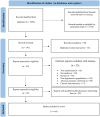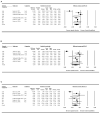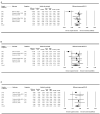Effects of Aquatic Exercise in Post-exercise Hypotension: A Systematic Review and Meta-Analysis
- PMID: 35173635
- PMCID: PMC8841763
- DOI: 10.3389/fphys.2022.834812
Effects of Aquatic Exercise in Post-exercise Hypotension: A Systematic Review and Meta-Analysis
Abstract
Background: Post-exercise hypotension (PEH) can be an important non-pharmacological strategy in the treatment of arterial hypertension. Both aerobic and resistance exercises produce PEH, but it is not clear if the exercise environment can lead to a higher PEH.
Objective: This meta-analysis investigated whether a session of aquatic exercise (AE) induces PEH in comparison with control conditions such as land exercise (LE) or rest in hypertensive subjects.
Methods: The present systematic review and meta-analysis was conducted using the following electronic databases: PubMed, Google Scholar, and EMBASE. Ambulatory blood pressure measurements made in randomized clinical trials were pooled to compare PEH induced by AE with LE and rest conditions in hypertensive subjects.
Results: Data from four trials were included, which comprised 127 participants (94 women and 33 men). A 24-h analysis did not detect significant differences between AE and LE or rest for either systolic blood pressure (SBP) or diastolic blood pressure (DBP). Monitoring during the night showed that AE induced significant PEH in comparison with LE for SBP [-8.6 (-15.0 to -1.5) mmHg (p = 0.01)]. For DBP, the AE had pronounced PEH during the night in comparison with LE [-3.7 (-4.7 to -2.8) mmHg, p = 0.000] and rest [-1.7 (-1.9 to -0.8) mmHg, p = 0.000]. There were no differences in daytime values.
Conclusion: AE showed a higher PEH effect than LE sessions and rest conditions. PEH was observed in both SBP and DBP during the night. The number of studies was low, but all studies included in this meta-analysis used 24-h monitoring. The understanding of clinical relevance of AE, inducing a higher PEH, depends on a standardization of exercise protocols plus a rigorous monitoring of blood pressure.
Systematic review registration: PROSPERO registration: CRD42021271928.
Keywords: ambulatory blood pressure; aquatic exercise; exercise; post-exercise hypotension; systematic review and meta-analysis; water-based exercise.
Copyright © 2022 Trindade, Oliveira, Coelho, Casonatto and Becker.
Conflict of interest statement
The authors declare that the research was conducted in the absence of any commercial or financial relationships that could be construed as a potential conflict of interest.
Figures



References
-
- Barone Gibbs B., Hivert M.-F., Jerome G. J., Kraus W. E., Rosenkranz S. K., Schorr E. N., et al. . (2021). Physical activity as a critical component of first-line treatment for elevated blood pressure or cholesterol: who, what, and how? A scientific statement from the American Heart Association. Hypertension. 78, e26–e37. 10.1161/HYP.0000000000000196 - DOI - PubMed
-
- Bocalini D. S., Bergamin M., Evangelista A. L., Rica R. L., Pontes F. L., Figueira A., et al. . (2017). Post-exercise hypotension and heart rate variability response after water- and land-ergometry exercise in hypertensive patients. Csernoch, L., editor. PLoS ONE. 12, e0180216. 10.1371/journal.pone.0180216 - DOI - PMC - PubMed
-
- Chien K.-Y., Chen W.-C., Kan N.-W., Hsu M.-C., Lee S.-L. (2015). Responses of blood pressure and lactate levels to various aquatic exercise movements in postmenopausal women. J. Sports Med. Phys. Fitness. 55, 1423–1430. - PubMed
Publication types
LinkOut - more resources
Full Text Sources

